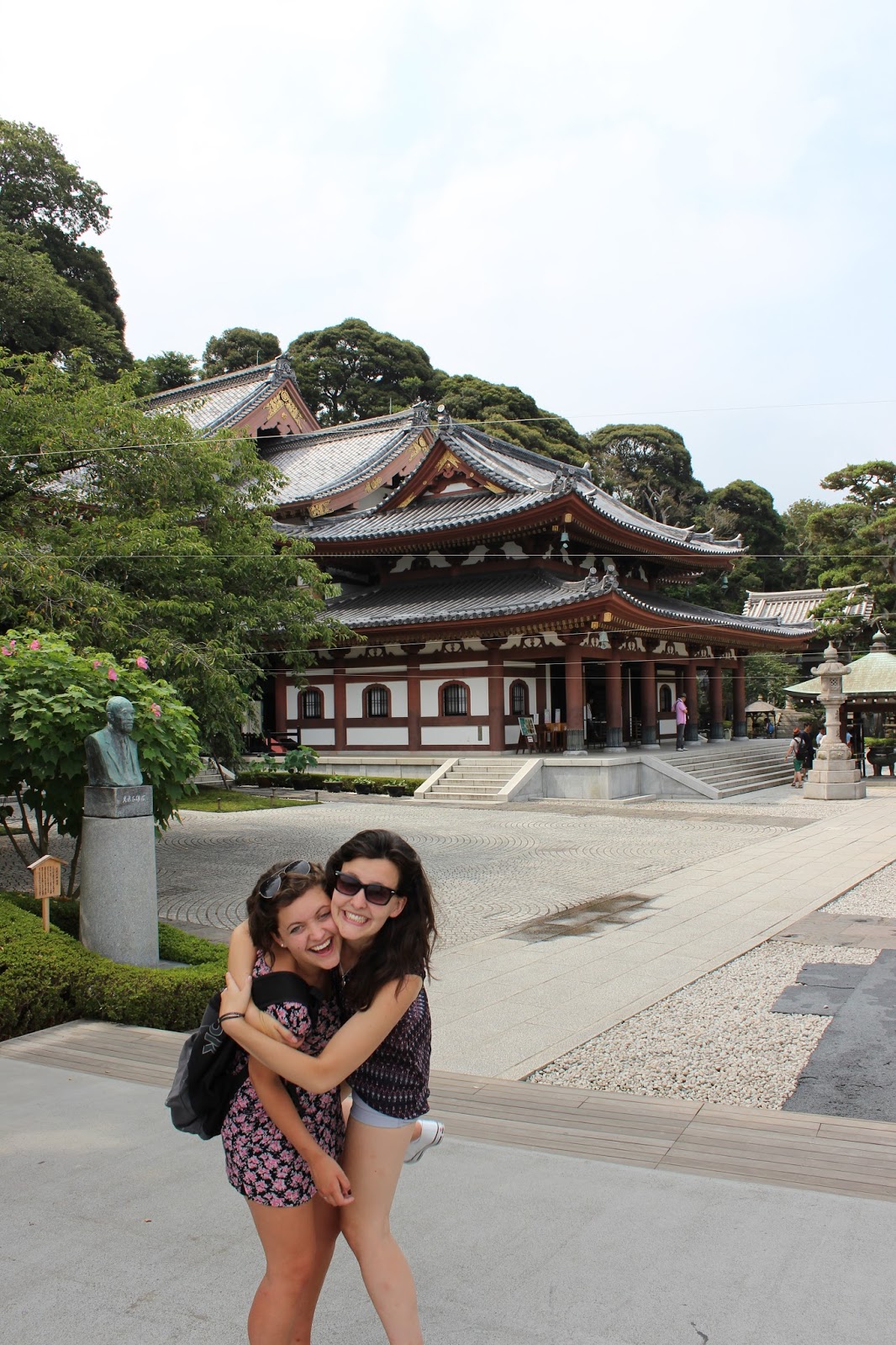On
the 24th July, we all embarked on our first trip outside Numazu. We
were bound for Kamakura, just an hour and a half North of Numazu, and an hour
South of Tokyo in Kanagawa Prefecture.
Kamakura
was Japans first feudal capital. Its glory days coincided with the spread of
populist Buddhism in Japan, a legacy reflected in the areas high concentration of
stunning temples and statuary. Contemporary residents have added a laid-back vibe complete with many restaurants and summer beach shacks – which can
be added to sunrise meditation and hillside hikes as reasons to visit.
 |
| The Great Daibutsu - Kamakuras most iconic sight |
As
we stepped off the train, I grabbed a walking map of Kamakura from the
information desk. Kamakuras most iconic sight is an 11.4 meter statue of the The
Great Daibutsu (Buddha), and this was our first stop. So how hard can it be to
find a massive iconic Buddha? Rather difficult actually! As soon as we started walking we had no
idea where we were going. As I have said in previous posts, when you pull out a
map in Japan you can pretty much guarantee that a Japanese person will ask if
you are okay. True to form, a small little Japanese lady hurried over to ask if
we were okay. I said we were looking for the Daibutsu, she turned around the
way she came and told us she would take us there.
How kind I thought, but surely it’s not that far, especially as we had a walking map in hand. Half an hour later and we were still climbing a mountain, Tom was dying from the humidity but the Japanese lady continued to bounce along merrily carrying her weekly shop. Often I think Japanese people want to talk to English people to help brush up on the old English skills, but this lady happily just marched in front and 40 minutes later, dropped us off right at the entrance of the Great Buddha, and walked back the way we came.
It was 500 Yen to see the Buddha, it was raining earlier in the morning so it was rather quiet which was nice. So we came to Kamakura to see the Great Buddha and well it was a big, massive Buddha, exactly what you expected! Obviously, it was a great sight and the Buddha is hollow so for an extra 20 Yen visitors can view the interior.
 |
| Ink and water colour sketch |
 |
| Tom, James, Ali and I - we lived together at university for 3 years and the last place we thought we would be re-united is Japan! |
Next,
we visited Hasedera Temple, which was a short 10 minute walk downhill from the
Buddha and 300 Yen to enter. This was James’s favourite place from the whole
trip. Hasedera is built along the slope of a wooded hill and split across
several levels. As we entered we enjoyed the beautiful traditional Japanese gardens
and a spectacular view from the viewing platform which provided a panoramic of
the town and the bay.
On
the same level as the gardens there was a small cave, called benten kutsu cave.
The ceiling was extremely low so poor James struggled a little as we wound our
way through the tunnel. There were many statues and devotionals to Benzaiten,
the sea goddess and the only female of the Seven Lucky Gods in Japanese
mythology.
Wooden
plaques adorn the entrance of the temple (near the cave), these are found at
all Shinto temples and are tokens of good luck. Many people write a wish on the
plaque which they hang up in the hope that the wish will come true. We decided
to add to the wall but nobody could decide what to write, especially as many of
those hanging up were really deep and heart wrenching.
 |
| Our wish!! |
Further
up the slope is the temples main hall – Kannon-do Hall. The focal point of the
temples main hall is a 9.18 metre carved wooden juichimen (11-faced) Kannon
statue. In addition to the main head, three heads are in front, three to the
left, three to the right, one on the top and another at the back. Each face has
a different expression, signifying that the deity listens to the wishes of all
types of people. It is covered in gold leaf and it is a really exquisite
statue. Unfortunately no photos were aloud inside the main hall.
The
temple is also famous for the Jizo shrine where there are numerous small Jizo figurines
laid out by parents dedicating them for their unborn children lost in
miscarriage or abortion. It is to help the souls of the dead children to reach
paradise. There are thousands of Jizo figurines which is really heartbreaking.
Apparently, statues remain in place for about a year before being removed to
make way for more statues; it is estimated that some 50 000 Jizo statues have been
placed since WW2.
After the temple we were all cultured out for one day, so we headed to the beach for some Mexican food, bear and beach games before wrapping up our time in Kamakura and taking the train back to Numazu. (Before jumping on the train we did try and find the famous, sweet potato ice-cream, but to no avail as shops were closing up for the day).
 |
| Jizo figurines |
 |
| Mary and I at Hasedera Temples main hall - Kannon-do |
 |
| Steps leading down to the garden |
A very successful day trip to Kamakura with great company, next on the itinerary, climbing Mt Fuji!
Marion

No comments:
Post a Comment